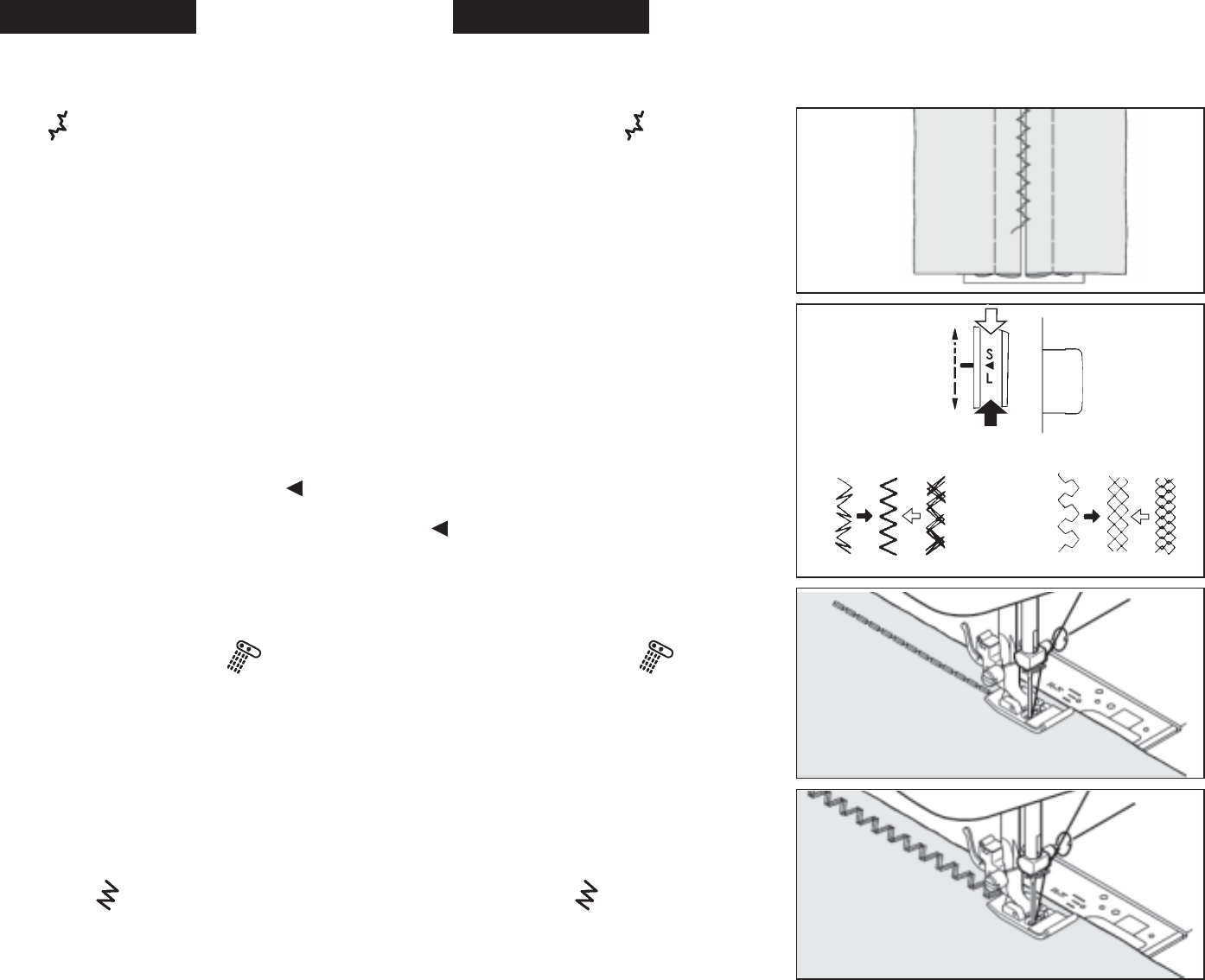
36
PUNTADA RECTA TRIPLE
La puntada recta triple es mucho más fuerte que la puntada
recta corriente, ya que entrelaza tres veces–hacia adelante,
hacia atrás y hacia adelante.
Es particularmente adecuada para reforzar las costuras de
prendas deportivas de tejidos elásticos y no elásticos y
para costuras curvas que requieren una gran resistencia.
Utilizar también esta puntada para sobrecoser solapas
redondeadas, cuellos y puños, ya que proporciona un
acabado profesional a las prendas.
PUNTADA RIC RAC
El zig-zag es un método rápido de acabado de un borde y
proporciona una sobrecostura decorativa en una
operación. Es ideal para escotes, sisas, mangas y
dobladillos.Ce point s’utilise surtout pour surfiler les cols,
entrées de manches et manchettes, ainsi que les ourlets.
ENGLISH ESPAÑOL
FAGGOTING
This is a popular decorative stitch (used in sleeves or fronts
of blouses and dresses). To attach two separate pieces of
fabric together, leave a little space in between. To prepare
the fabric:
Fold under the seam allowances on the cut edges, and
press. Baste folded edges to tissue paper with about 1/8"
(0.3 cm) space between. Stitch over the 1/8" (0.3 cm)
allowance, just catching the fabric fold on both sides with
needle. Remove bastings and paper; press.
HACES (Diente de rata)
Esta es una puntada muy popular (usada en mangas o
delanteros de blusas y vestidos).
Para sujetar dos piezas separadas de tejido dejar un
pequeño espacio entre ellas. Para preparar el tejido: Doblar
el tejido hacia abajo y presionarlo. Hilvanar los bordes
doblados al papel de seda, dejando un espacio de 1/8".
Coser por encima del espacio de 1/8", cogiendo con la
aguja el género doblado por ambos lados. Sacar los
hilvanes y el papel; planchar.
STRETCH STITCHES
Stretch stitches are mainly for use on knit, or stretchable
fabrics, but can also be used on ordinary materials.
Use the stretch stitch needle with yellow shank when sewing
on stretchable fabric. Use normal needles for non-
stretchable fabrics.
ADJUSTING STRETCH STITCH BALANCE
Stitch length/super (stretch) stitch control should be at WT
mark for most materials. Depending upon the type of fabric
used, you may need to adjust this Control to match forward
stitches of stretch sewing with reverse motion stitches. If
the stitches are too open, turn the Control to S position; if
the stitches overlap, turn the Control to L position.
PUNTADAS ELASTICAS
Las puntadas elásticas se utilizan principalmente en
géneros de punto o materiales elásticos, pero también se
puede usar en materiales corrientes.
Utilizar la aguja de punta a bola, cuando se cosan tejidos
elásticos. Utilizar las agujas normales para los tejidos no
elásticos.
AJUSTE FINO PUNTADA ELASTICA
El control del largo de puntada/super (elástica), debe de estar
en la marca WTpara la mayoría de materiales. Dependiendo
del tipo de material a coser, usted deberá ajustar este control
para conseguir igualar las puntadas hacia adelante con las
puntadas de atrás. Si las puntadas son demasiado abiertas
girar el control a la posición S; si las puntadas se sobreponen,
girar el control a la posición L.
STRAIGHT STRETCH STITCH
Straight stretch stitch is far stronger than an ordinary straight
stitch because it locks three times
-
forwards, backwards
and forwards.
It is particularly suitable for reinforcing the seams of
sportswear in stretch and non-stretch fabrics, and for curved
seams which take a lot of strain.
Use this stitch also to top-stitch around lapels, collars and
cuffs to give a professional finish to your garments.
RIC-RAC STITCH
Ric-rac is a quick method of finishing a raw edge and
providing a decorative top-stitch in one operation. It is ideal
for edging neck-bands, armholes, sleeves and hems.
Ric-rac Stitch
Puntada Ric rac
Honeycomb Stitch
Puntada Panal
S L S L


















